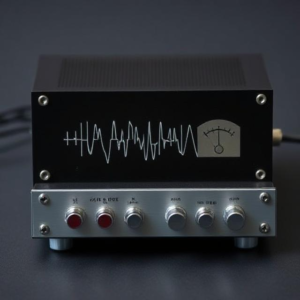What is a Differential Amplifier?
A differential amplifier is an electronic circuit that amplifies the difference between two input signals. It takes two signals, compares them, and then produces an output that is proportional to the difference between those two signals.

Think of it like comparing two numbers and then amplifying the difference between them.
Key Features of a Differential Amplifier:
- Two Inputs: A differential amplifier has two input signals: one is called the inverting input (–), and the other is called the non-inverting input (+).
- Inverting Input (–): The signal that is flipped or inverted in phase when processed.
- Non-inverting Input (+): The signal that is not flipped or inverted.
- Output: The output of the amplifier is a difference between the two input signals. The output is amplified (made bigger) based on that difference.
- Amplification of the Difference: The key thing is that the amplifier only cares about the difference between the two input signals. It doesn’t just add the signals together but looks at how much one signal is higher or lower than the other.
Example:
If you have two input signals like:
- Input 1: 5V
- Input 2: 3V
The difference is 2V (5V – 3V).
The differential amplifier will then amplify this difference and give you a bigger output (let’s say 10 times bigger, for example). So, the output might be 20V.
The Working of a Differential Amplifier:
- Input Signals: You apply two signals to the two input terminals (one to the non-inverting input and the other to the inverting input).
- Difference Calculation: The differential amplifier subtracts the inverting input from the non-inverting input. So, if the voltage at the non-inverting input is higher than the inverting input, the output will be positive. If the inverting input is higher, the output will be negative.
- Amplification: The difference is then multiplied by a factor called gain (which controls how much the difference is amplified). This produces the final output.
Why Use a Differential Amplifier?
- Noise Reduction: One of the biggest advantages of differential amplifiers is that they help cancel out noise. If both input signals experience the same noise (like from an external source), the differential amplifier will subtract it out. This means it can focus on the actual difference between the two signals without being affected by common noise.
- Improved Accuracy: Differential amplifiers are often used when you need to measure very small differences between two signals and need to amplify these differences accurately.
- Operational Amplifiers (Op-Amps): A differential amplifier is often built using an operational amplifier (op-amp), which is a type of electronic device that can amplify signals.
Where Are Differential Amplifiers Used?
- Signal Processing: Used in electronics to measure the difference between two signals, especially when signals are noisy or weak.
- Instrumentation: Used in devices like oscilloscopes and medical equipment (such as ECGs) to measure the difference between voltages in biological signals.
- Audio Equipment: Differential amplifiers are used in microphones or mixers to amplify the difference between audio signals, removing unwanted noise.
- Measurement Systems: In systems that measure very small voltage differences, like temperature sensors or strain gauges, differential amplifiers help amplify these small differences for accurate readings.
Simple Example:
Let’s say you’re using a differential amplifier in a system where you need to measure the difference between two temperatures (for example, the output of two sensors). One sensor might read 20°C, and the other sensor reads 19.5°C. The difference between them is 0.5°C. The differential amplifier will amplify that small difference so it can be easily measured and used in further calculations.
In Summary:
- A differential amplifier amplifies the difference between two input signals.
- It has two inputs: one non-inverting and one inverting.
- The output depends on the difference between the inputs, which is then amplified.
- Noise cancellation and accurate measurement are two key advantages.
- Op-amps (operational amplifiers) are often used to build differential amplifiers.
In short, differential amplifiers are very useful when you need to amplify and measure small voltage differences in a way that reduces noise and provides clearer, more accurate results.
Keywords: Amplifier, Electronics


